home and car insurance quotes online commercial vehicle insurance online quote business vehicle insurance quote commercial …
commercial vehicle insurance online quote || business vehicle insurance quote ||
Emma and Ellie Pretends to Play Wanted Police Chase Adventure | Police Videos for Kids
Emma and Ellie pretend to play as a police officer on a wanted police chase adventure. Funny police video for kids. Emma is a police off in training and tries to …
Visitor Health Insurance USA | Best Medical Insurance Plans for US | Visitor Guard®
Buy the best Health Insurance for Visitors to the USA https://www.visitorguard.com/health-insurance/ Visitor Guard® provides …
What Do the Warning Lights on My Dashboard Mean?
It’s a scenario we’ve all experienced: you’re driving down the road, and suddenly, you hear a beep and notice that a bright symbol has appeared on your car’s dashboard. Whether it’s to signal that your tires are low or that a door is open, dashboard warning lights are how your car communicates that something isn’t quite right. When a new light comes on, it’s easy to begin worrying about a potential visit to the mechanic. However, not all symbols represent a significant issue. Let’s explore some of the most common dashboard warning lights and what they mean.
The Different Types of Car Dashboard Symbols
Before we dive into what common dashboard warning lights mean, it’s important to understand the different types of symbols that can appear. Although it can vary depending on your car’s model, most warning lights on a dashboard will come in three colors: green/blue, orange/yellow, and red.
In most vehicles, a green or blue light indicates that a system or feature is operating, such as cruise control. Orange or yellow symbols draw your attention to something you should be aware of, such as your car activating traction control. A red symbol will generally indicate that a significant issue or failure has occurred and that you should service your vehicle as soon as possible.
Note: Every vehicle is different, so some dashboard warning lights may vary slightly in appearance and meaning between car models. Always refer to your vehicle’s owner’s manual to understand your car’s signs.
10 of the Most Common Dashboard Warning Lights
1. Check Engine Light
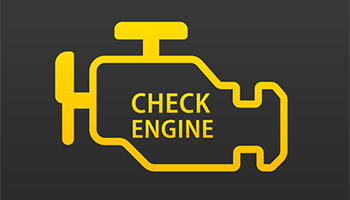
Starting off our list is one of the most common warning lights that can appear on your dashboard: the check engine light. The silhouette of an engine usually represents the check engine symbol, but it can also sometimes be an all-caps “CHECK ENGINE” message. Although this may seem major, there are plenty of reasons why a car’s check engine light can turn on, some of which aren’t serious. A loose gas cap, low oil pressure, overheating issues, and misfires can all trigger your car’s check engine light.
What to do: If you’re driving and the check engine light comes on, don’t panic. If your car is still running normally and you don’t notice any changes, you don’t have to pull over immediately. Still, you should schedule a time to visit a mechanic or an AutoZone to determine the issue using an OBD reader. However, if your vehicle begins to make loud noises and the light repeatedly flashes, pull over and call for a tow. In these situations, the flashing symbol indicates a larger issue with your car’s engine.
2. Oil Pressure Light
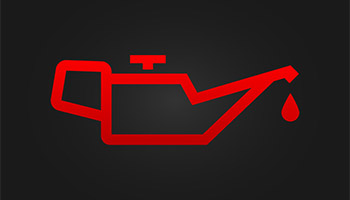
Engine oil keeps your engine running smoothly by lubricating its moving parts to reduce friction and damage. If your car detects low oil levels or pressure, it will trigger the oil pressure light. This symbol will typically be red and resemble a genie’s lamp. Although most drivers will likely never experience this sign, it shouldn’t be taken lightly. Running your car with insufficient oil levels can cause major damage to your engine.
What to do: If your oil pressure warning light turns on, pull over whenever it is safe. After letting the car sit for 10 minutes, check your oil levels. If your levels are low, add more oil and see if the light returns. If it doesn’t, you’re in luck! However, if the light remains on, a deeper issue could require a professional inspection. We recommend servicing your vehicle whenever the oil pressure light comes on to avoid unnecessary damage.
3. Tire Pressure Monitoring System Light
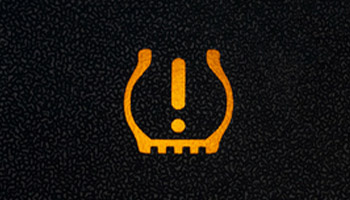
Low tire pressure will trigger your car’s tire pressure monitoring system warning, often represented as two-thirds of a circle with an exclamation point in the middle. Driving with under or over-inflated tires could result in an accident, so you should rectify the issue immediately. Most modern cars may even tell you the exact pressure levels of each tire.
What to do: After noticing the tire pressure symbol, head to a nearby gas station to use an air station. When filling up your tire, try to locate any nails or screws which could be causing air to leak. If you aren’t sure what PSI your tires should be at, refer to your owner’s manual or the tire information sticker on the inside of the driver’s door.
4. Battery Warning Light

Your car’s battery plays a significant role in starting your vehicle and powering its systems. If you’ve experienced a dead battery before, you know how stressful the cranking sound can be. When your battery warning light comes on, it typically means an issue with your vehicle’s charging system. Potential problems include a damaged or loose battery cable, a bad alternator, or an additional electrical fault.
What to do: It is possible for your car to run smoothly even if the battery dashboard warning light is on. However, you shouldn’t take this issue lightly. If you notice the battery light comes on, your first step should be to inspect the battery for any loose cables or corrosion. You can also use a multimeter to check the battery’s charge. A healthy battery should read around 12.6 volts when the car is off. If your battery has a resting voltage below 12 volts, consider having a professional inspect it before replacing it to ensure there isn’t an underlying issue affecting the battery charge.
5. Engine Temperature Warning Light
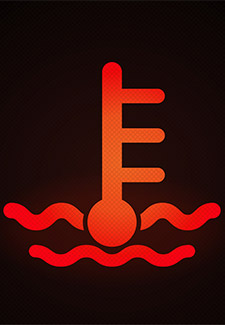
This warning light is one of the more straightforward symbols to decipher. You should act quickly if you see the engine temperature symbol (typically a thermometer dipping into water). Potential reasons for this warning light’s appearance include coolant issues, a clogged radiator, or a blown head gasket. Either way, you should not drive with the engine temperature light on for an extended period. Doing so could cause significant damage to your car’s engine.
What to do: If you’re driving and the engine temperature warning light comes on, pull over when it is safe. Allow your car to cool down for at least 15 minutes. Remember not to open your car’s hood while it is overheating, as the high temperatures could cause burns or injuries. While you wait for your engine to cool, consider calling for roadside assistance or scheduling a visit to the mechanic. Topping off your coolant may help in some cases, but if you have a leak, you may need professional help.
6. Brake System Warning Light
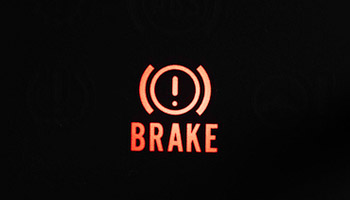
Sure, we all love to talk about how fast our cars can accelerate from 0 to 60 mph. But no matter what car you drive, braking is as important (if not more) than speed. If you can’t come to a quick and controlled stop, you could put yourself and others in a dangerous situation. In most cases, your car’s brake system warning light will appear if you drive off with your parking brake still activated. However, worn brake pads, low brake fluids, or issues involving the car’s anti-lock braking system (ABS) could also cause this dashboard warning light to turn on.
What to do: Always check to see if your parking brake is engaged when the brake system warning light illuminates. In most cases, resetting the parking brake will fix the problem. However, if the light is still on, we recommend servicing your vehicle as soon as possible to detect the issue. Driving with a faulty brake system can cause serious accidents, so you don’t want to delay the repair.
7. Traction Control Light
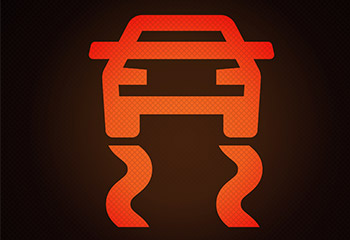
Your vehicle has built-in systems that help you maintain control in different road conditions. Traction control, for example, allows a car to maintain its grip between its tires and the road in slippery conditions. You will know your traction control is working when you see the symbol of a car with curvy lines ahead of it. Your traction control warning light will activate if your tires spin faster than the speed your car is going, which will prevent you from hydroplaning or skidding.
What to do: Your traction control light will typically turn on when the feature is active. Although it does not usually indicate a serious problem, you should proceed cautiously, as the light could mean your vehicle briefly lost its grip on the road. If you’ve switched traction control off, the symbol may appear with the words “OFF” underneath. Turning the traction control back on will remove the “OFF” message.
8. Fog Light Indicator
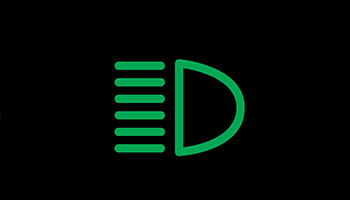
As mentioned, not all dashboard symbols represent a severe problem. If you’re driving with fog lamps on, your car will usually tell you with a green or blue headlight symbol. It’s important to be aware of when your fog lights are activated, as they can affect visibility for other drivers on the road.
What to do: Fog lights should only be used when visibility is less than 100 yards. If you are driving in clear conditions, your fog lights should not be on.
9) Low Washer Fluid Warning
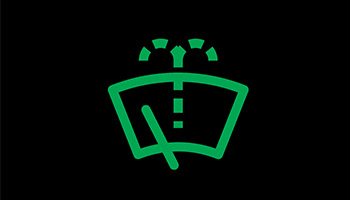
The washer fluid light is one of the easier symbols to recognize and will not require any professional help to fix. If you see this symbol on your dashboard, it simply means that you are low on washer fluid. Although not a call for concern, you should top your washer fluid off whenever possible to maintain clear visibility.
What to do: If your washer fluid warning light comes on, all you need to do is add more fluid to the reservoir. Most cars will use the same symbol on the fluid reservoir cap, making it easy to locate underneath the hood.
10) Low Fuel Warning
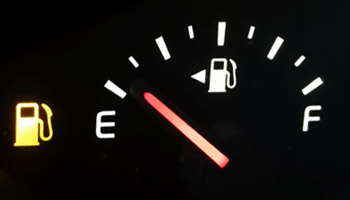
Ending our list is one symbol every driver has likely experienced: the low fuel warning light. Each vehicle will have different fuel levels that trigger this warning light, but it often means that you have about one or two gallons of fuel left.
What to do: Don’t push your luck when the low fuel warning light comes on. Even if you aren’t far from your destination, unexpected traffic or delays could cause you to run out of fuel quicker than you thought. Sometimes, a loose gas cap could also trigger this warning light.
Learn More About Car Maintenance
Want to read more about car maintenance projects you can do at home? Check out the DIY section of our blog to discover more ways to service your car without breaking the bank. Whether you’re looking for ways to clear foggy headlights or tips on how to keep your vehicle running smoothly, we’ve got you covered. For more information on how AIS can help with your insurance needs, click here.
The information in this article is obtained from various sources and is offered for educational purposes. Furthermore, it should not replace manuals or instructions provided by the manufacturer or the advice of a qualified professional. No warranty or appropriateness for a specific purpose is expressed or implied.
‘Pay How You Drive’ Car Insurance
Ferrari just called and they want you to be their next F1 driver That was a dream and a bad joke If you think you’re someone …
I'm on a Sugar Crash Minecraft TikTok Compilation
like & subscribe 🙂 I didn’t make any of the featured videos! PART 2: https://youtu.be/NbB5gW5nnww Join my Discord: https://discord.gg/skrwF9pzZq Follow …
How Many Catalytic Converters Were Stolen in My State?
Since 2019, catalytic converter thefts have skyrocketed to record highs. However, new state legislation and a decline in the price of precious metals have slowly reduced the number of overall thefts. According to a report by BeenVerified, approximately 26,742 catalytic converters were stolen nationwide during the first six months of 2023, representing a 43% decrease from the same period last year. Despite this downward trend, catalytic converter thefts remain significantly higher than in 2019, which saw only 3,389 thefts nationwide.
Let’s take a closer look at the data to help you better understand the situation and how you can prevent yourself from being a victim of converter theft.
Key Takeaways:
- There were approximately 26,742 catalytic converter thefts during the first six months of 2023, representing a 43% decrease from the same period in 2022.
- California, Texas, New York, and Illinois lead the nation in total catalytic converter thefts so far this year, with 6,988, 2,235, 2,071, and 1,354 thefts, respectively.
- The average cost of rhodium, the most expensive metal found inside most catalytic converters, is around $131/gram. In 2021, rhodium hit an all-time high of $958/gram.
Total Catalytic Converter Thefts by State During First Half of 2023
Although catalytic converter thefts are down compared to 2022, thefts are still significantly higher than in 2019, according to the BeenVerified report. Here’s a rundown of how many catalytic converters were stolen by state during the first six months of 2023 using data from the NICB and BeenVerified.
| State | 2023 thefts* | State | 2023 thefts* | State | 2023 thefts* |
| Alabama | 179 | Louisiana | 200 | Ohio | 613 |
| Alaska | 30 | Maine | 47 | Oklahoma | 137 |
| Arizona | 430 | Maryland | 443 | Oregon | 222 |
| Arkansas | 122 | Massachusetts | 529 | Pennsylvania | 1,062 |
| California | 6,998 | Michigan | 520 | Rhode Island | 75 |
| Colorado | 702 | Minnesota | 393 | South Carolina | 195 |
| Connecticut | 419 | Mississippi | 83 | South Dakota | 35 |
| Delaware | 93 | Missouri | 314 | Tennessee | 292 |
| Florida | 1,299 | Montana | 42 | Texas | 2,335 |
| Georgia | 563 | Nebraska | 84 | Utah | 129 |
| Hawaii | 65 | Nevada | 348 | Vermont | 28 |
| Idaho | 56 | New Hampshire | 64 | Virginia | 550 |
| Illinois | 1,354 | New Jersey | 1,400 | Washington | 527 |
| Indiana | 289 | New Mexico | 161 | Wisconsin | 247 |
| Iowa | 107 | New York | 2,071 | West Virginia | 48 |
| Kansas | 143 | North Carolina | 490 | Wyoming | 23 |
| Kentucky | 159 | North Dakota | 27 |
*Number of thefts during the first six months of 2023 according to BeenVerified and the NICB data.
Of all 50 states, California, Texas, and New York have experienced the most catalytic converter thefts this year, with 6,988, 2,235, and 2,071 total thefts, respectively. When comparing thefts per 100,000 registered vehicles in each state, New York came in first place with 11.14 thefts, followed by New Jersey with 9.29 and Delaware with 8.81, according to BeenVerified.
Which Car Models Are More Prone to Converter Theft?
Although every gas-powered car since 1974 is required to have catalytic converters, not all models are targeted the same. Unfortunately for some, a few vehicle types routinely experience greater thefts than others. According to CarFax, these were the top cars targeted for catalytic converter theft in 2022:
| Rank | Make and Model | Rank | Make and Model |
| 1 | Ford F Series Truck | 6 | Ford Econoline |
| 2 | Honda Accord | 7 | Chevrolet Equinox |
| 3 | Toyota Prius | 8 | Chevrolet Silverado |
| 4 | Honda CR-V | 9 | Toyota Tacoma |
| 5 | Ford Explorer | 10 | Chevrolet Cruze |
Why Do Thieves Routinely Target Catalytic Converters?

Since 2019, catalytic converters have been a popular target for thieves hoping to cash in on the precious metals located inside the car part. A typical catalytic converter will contain varying amounts of platinum, palladium, and rhodium.
Out of all three metals, rhodium is the most expensive. However, the price of these metals has dropped significantly throughout the last few years, which is a potential reason for the decrease in thefts. For example, at the time of this writing, rhodium is worth around $131/gram. In 2021, the metal hit a record all-time high of $958/gram. There are typically 1-2 grams of rhodium alone inside a catalytic converter.
A converter’s location on a vehicle also makes it an easy target. Since it is located on the back underside of the vehicle, it only takes a minute or two and a reciprocating saw to extract the converter from the exhaust pipe. This is why vehicles with higher ground clearance are routinely victims of theft.
How Have States Responded to Catalytic Converter Thefts?

To combat thefts, multiple states have passed legislation that seeks to prevent thefts with increased penalties. Here’s a quick rundown of legislation passed in states with some of the highest reported thefts in the country:
- California – The Golden State passed multiple bills in 2022 that address catalytic converter thefts. For example, SB 1087 limits who can legally sell a catalytic converter, while AB 1750 requires metal recyclers to maintain stricter documentation of when and where they purchased used converters.
- Texas – In Texas, Gov. Abbott has recently signed a bill into law known as the Deputy Darren Almendarez Act, which creates new criminal penalties for thefts and allows prosecutors to treat thefts as organized crime. The bill is named after a deputy who lost their life attempting to stop a converter theft.
- New Jersey – New Jersey has followed similar steps as California with S249/A2210 by increasing the documentation metal recyclers must adhere to when purchasing used converters.
What You Can Do to Help Prevent Catalytic Converter Theft
According to the NICB, making it difficult for thieves to access your vehicle’s catalytic converter is the best way to prevent theft. Here are a few tips to follow:
- Install an anti-theft device – Some auto shops have begun installing steel plates or cages around catalytic converts, significantly increasing the work required to steal them. Additionally, vibration-sensitive car alarms can cause a potential thief to think twice.
- Park strategically – It is wise to park your car inside a garage or secured lot whenever possible. If you have a driveway, consider backing into your space so your car’s backend isn’t towards the street. Motion-activated lights can also scare a thief from initiating the crime.
- Vin Etching – Keep an eye out for local law enforcement or city-sponsored events that provide free VIN etching onto your catalytic converter. Etching your car’s VIN onto your catalytic converter can make it easier to trace a loose converter back to your car. Additionally, thanks to new legislation in some states, thieves cannot sell an etched converter that they cannot prove came from their own vehicle.
Keep Yourself Protected with Comprehensive Insurance
If your catalytic converter is stolen, you’ll need comprehensive insurance to file a claim for a replacement. Comprehensive coverage isn’t legally required in any state, but your lender may require it if you lease or finance a car. If you’re searching for comprehensive coverage, our insurance specialists can help. With AIS, you can compare rates from our network of trusted insurance partners. Call us today at (888) 772-4247, or start a quote online to get started.
The information in this article is obtained from various sources and is offered for educational purposes. Furthermore, it should not replace manuals or instructions provided by the manufacturer or the advice of a qualified professional. No warranty or appropriateness for a specific purpose is expressed or implied.
The best way to shop for car insurance online | Pay less for insurance with an app
Getting a quote on your car and/or home insurance has always been a hassle. Calling multiples companies and getting schooled …
HEALTH INSURANCE CLAIMS PROCESS IN HINDI | REIMBURSEMENT IN HEALTHCARE | HEALTH INSURANCE CLAIMS
?? ?????? ?? ????? ?? ???? ????? ?????? ?? ????? ????????? ??? ???? ???? ????? ??? ?????? ????? ??? ?? ????, …
LIMITED Pay VS REGULAR Pay Term Insurance | Life Insurance Premiums COMPARISON | Gurleen Kaur Tikku
In Regular pay premium payment option the policyholders are required to pay the premiums throughout the policy tenure to enjoy …
How to Reduce Inventory Shrinkage and Save Money: 6 Proven Tips
Inventory shrinkage is a major growing problem, costing businesses billions of dollars annually. It can be especially devastating for retailers, who often operate on tight margins, as even a small amount of shrinkage can significantly impact profits. In this article, we will discuss what inventory shrinkage is, how to reduce it, and which insurance policies can help you financially recover from theft so you can focus on running your business.
What is Shrinkage?

Shrinkage is the loss of physical inventory caused by a variety of factors, such as employee theft, shoplifting, administrative and operational error, and damaged or expired goods. It is the difference between your actual inventory and the amount your records say you should have. For example, a retailer with $1 million in recorded inventory may find they only have $750,000 in actual inventory after a physical count. This indicates the retailer has experienced $250,000 in shrinkage. According to the National Retail Federation (NRF), inventory shrinkage costs the retail industry an estimated $94.5 billion in 2021. However, the good news is you can reduce inventory shrinkage by putting a few simple processes in place.
6 Ways to Reduce Inventory Shrinkage
While it is impossible to eliminate inventory shrinkage entirely, there are several steps businesses can take to reduce it.
1. Train Your Employees
Employee theft is a major cause of inventory shrinkage, accounting for 42% of all losses. You can significantly reduce inventory shrinkage and protect your profits by training your employees on proper inventory management procedures, creating a culture of honesty and accountability, and theft prevention techniques.
2. Conduct Periodic Inventory Check
Periodic inventory checks are essential for preventing shrinkage because they allow you to identify potential losses and address discrepancies before they become too costly. A good rule of thumb is to conduct a full inventory check at least once a quarter and more frequently for high-value items.
3. Use Technology to Prevent Shrinkage

A variety of technologies are available to help businesses prevent theft and loss, including:
- Security tags -These tags deter theft by triggering alarms if the product is removed from the store without being paid for.
- RFID tags – Radio frequency identification tags track the movement of products throughout your warehouse, store, or supply chain and identify stolen products.
- SKU and barcodes – Stock keeping units (SKUs) and barcodes help automate inventory management and track the movement of products within the warehouse or store.
4. Implement Inventory Automation
Automated inventory management software helps businesses track their inventory levels in real-time and identify potential theft or losses more quickly. Additionally, this type of software can help to reduce manual labor, human error, and make it easier to identify missing items.
5. Set Up a Loss Prevention Plan
A loss prevention plan is a comprehensive document that outlines the steps your business will take to prevent theft and reduce shrinkage. It should include specific security procedures, inventory management, employee training, and so forth. It’s important to communicate this plan to all employees and ensure they understand their role in preventing theft and reducing shrinkage. As your business grows or changes, your loss prevention plan should also be updated to reflect those changes.
6. Optimize Your Warehouse and Store Security

One of the most effective ways to prevent inventory shrinkage is to improve security in your warehouse and store. CCTV cameras can help deter theft and protect your inventory, but there are other important security measures to consider, such as:
- Access control systems – These systems can restrict who has access to your warehouse and store and when they can enter and exit.
- Security guards – Security guards can provide a visible presence and deter theft, especially during off-hours.
- Intrusion detection systems – These systems can detect unauthorized entry into your warehouse or store and alert you of a break-in.
- Motion sensor lighting – Well-lit areas make it more difficult for thieves to operate undetected.
How to Calculate Inventory Shrinkage
Retail shrinkage is the discrepancy between recorded inventory and actual inventory. To calculate shrinkage, we use the following formula:
| Shrinkage = Recorded inventory – Actual inventory |
To better understand how much money a retailer loses to shrinkage, we can calculate the shrinkage rate as a percentage of total sales. A higher shrinkage rate means that the retailer is losing more money to shrinkage. The shrinkage rate is calculated using the following formula:
| Shrinkage Rate = (Shrinkage amount / Total Sales) x 100 |
So, what is an acceptable inventory shrinkage rate? As stated before, the retail industry’s average shrink rate was 1.44% in 2021 which resulted in over $94 billion lost. In other words, an acceptable inventory shrinkage rate should be as small as possible.
What Type of Business Insurance Covers Theft?
In addition to improving your security and taking steps to prevent theft and reduce shrinkage, buying the right business insurance is key. However, it’s important to note that these insurance policies do not cover shrinkage since it is a normal part of doing business, and it is difficult to identify the source of the loss.
1. Commercial Crime Insurance

Also known as business crime insurance or fidelity insurance, protects businesses from financial losses caused by criminal acts such as theft, embezzlement, forgery, fraud, and cybercrime. It can cover cash, assets, merchandise, or other business property losses. This type of policy can be purchased as a standalone policy or added as part of a business owner’s policy (BOP).
2. Inland Marine Insurance

Inland marine insurance reimburses the cost related to equipment loss, theft, or damage while it is in transit or temporarily stored off-premises. It includes coverage for a business’s inventory, equipment, furniture, and documents. While standard business policies offer coverage up to $10,000, inland marine insurance significantly widens the scope of protection, providing more comprehensive coverage.
3. Commercial Property Insurance

Commercial property insurance covers damage or loss of your business property, including your building, inventory, and equipment. It typically covers theft, such as burglary, robbery, shoplifting, and employee theft.
Is Looting Covered by Business Insurance?
Looting is typically covered by commercial property insurance as it provides coverage for your building and all its content against vandalism, theft, fire, and explosions. However, it’s important to note that specific coverage varies from policy to policy. For example, some business insurance policies may have exclusions for looting that occurs during civil unrest or natural disasters. Be sure to carefully review your policy to understand what types of losses are covered and what exclusions may apply.
Get a Quote from AIS Insurance
Our dedicated commercial insurance team can help you compare insurance options, limits, and deductibles. We make it a priority to understand your business. Speak with one of our Commercial Insurance Specialists today at (855) 919-4247 for a quick and easy free quote.
The information in this article is obtained from various sources and offered for educational purposes only. Furthermore, it should not replace the advice of a qualified professional. The definitions, terms, and coverage in a given policy may differ from those suggested here. No warranty or appropriateness for a specific purpose is expressed or implied.
The Best Car Insurance For Teen Drivers: How To Save On Your Teen
Everyone knows that teen drivers cost more when it comes to car insurance. But let’s talk about how you can save money even …
10 New Three-Wheeler Vehicles Bending Regulations for Driving Fun in 2021
The middle ground offered by three-wheel vehicles has always been attractive to manufacturers. For car type of vehicles, it opens up the possibility to circumvent …
SBI Arogya Plus || Sbi Health Insurance Policy || Lifetime Same Premium || ?????? ?????? ????
sbiarogyaplus #sbihealthinsurance #??????-??????-???? #sbimediclaim HIGHLIGHTS This Video is About SBI Arogya Plus, Sbi Health Insurance Policy, …

